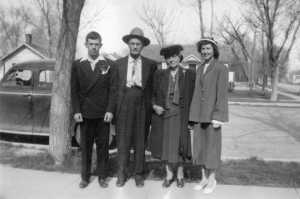
I’ve often envied those people who have a “hometown”…the place they were born, were raised, the place their grandparents are buried. A place they know so well…their memories all rolled up into one location. When I am asked where I’m from, where I call home…I’m never quite sure how to answer. Is it the place I was born? The place I lived at age five? The place I lived at age ten? The place I lived at age fifteen? The place I spent my twenties? The place I spent my thirties? The place I now live? The place my mother lives? The fact is that all of these places are in a different location.
I have recently come to realize that since arriving on this planet, I have had twenty-four mailing addresses in six different states. These were either places I lived with my parents, or places where I paid rent or a mortgage. This is not unusual for the family I grew up in, and no, my father was not in the military. If I add together the states my family members (mother, father, sister) have resided in, either together or separately, I estimate we have lived in at least fifteen states. I couldn’t even guess how many mailing addresses that would total. I should also mention that we haven’t just lived in a particular region like the Northeast or Southwest…we’ve hit them all… from California to New Jersey, Idaho to Alabama, New Mexico to Rhode Island and places in the middle like Missouri. There are places on this list that feel a bit more homey then some of the others. There’s an area in Bucks County, Pennsylvania where I graduated from high school. When I was planning my wedding back in the early 1990’s, I was living in Hoboken, New Jersey, my mother was living just outside of St. Louis, and my sister (the maid of honor) was living in San Diego. I had good memories of the scenic church we attended in Doylestown, Pennsylvania and thought, why not? It was a great place to have a wedding. I have some really great memories, but not much else connects me to that place now.
Perhaps my lack of a hometown is why I am so attracted to researching my ancestry. My seemingly shallow roots have sent me searching for something deeper. I think I’ve had it in my head that I might uncover some “place”… the place where it all started…a town or city where my people came from. A place I would arrive in and feel, yes, this is where I belong. What I’ve quickly discovered, however, is that I’ve come by my wanderlust quite earnestly. It wasn’t just me, my sister, or our parents following our dreams from place to place…it seems that is the family legacy on both my paternal and maternal sides. Movement. With few exceptions, I found that most of the individuals I am directly descended from were born in one state, married in another state, and died in a third. Looking back three and four generations I’ve found family located in California, Colorado, Nebraska, Illinois, Missouri, Ohio, Iowa, West Virginia, Kentucky, Tennessee, New York, Maryland, Virginia and Pennsylvania. It also seems that if one sibling was going to leave the family fold, yep, you guessed it, that person would be my direct grandmother or grandfather. Instead of that big solid oak tree I’ve been searching for, I’ve discovered my family is one big hulking mass of kudzu, spreading back and forth, east, west, north, and south across the United States and back again.
Ironically, one of the locations that through the years represented a sense of “home” to me is a place I’ve never lived. Western Nebraska is the place my parents grew up, my mother in the “big city” of Scottsbluff and my dad in the nearby town of Minatare. In the late 1960’s and 1970’s my sister and I were sent to stay with my grandparents in my father’s childhood home on the corner of 7th Street and Avenue C during summer vacations. It was hot, and dry, and full of mosquitoes. And it smelled like cattle shit. Always. You wanted the window open to catch a breeze, you wanted the window closed to keep the smell out. A fogging truck would come around in the early evenings to spray for the bugs, but it was too late, I’d be bitten head-to-toe upon arrival. To this day the smell of camphor—and the ever-present calamine lotion—brings me right back to those visits. I remember the horse that lived in the corral out back and the ever present swarm of wild kittens. I remember a parade of great-aunts and great-uncles with colorful names…uncle Bunny was married to Aunt Alice who wore sparkly cat-eye glasses and bright red lipstick…uncle Earl played the harmonica while grandpa played his banjo. The radio played country music or reported on crop or cattle prices. Lawrence Welk was on the television. A large dinner was served at lunchtime and a small supper was served in the evening. Dinners were family events with lots of people crowded around the table eating fried chicken, mashed potatoes or cold potato salad or hot German potato salad, corn, and my favorite marinated cucumbers. Uncle Woody and Uncle Charlie might stay to play cards. They all enjoyed arguing with each other—endlessly. I felt a bit uneasy in the presence of the vast, never ending plains just beyond the towns’ edge, but I was comforted by the view of the famous bluff from my grandparents’ backyard. I recall the howl of the wind and the sound of the freight trains that passed by several times a day. This place was vastly different from the place I normally spent my days.

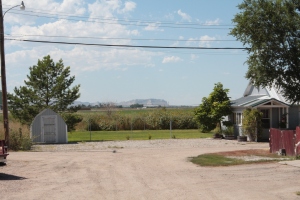
The town of Minatare was established in 1887—about twenty years after Nebraska became a state—in an area known as Sioux hunting grounds, and originally organized as the Minatare Canal and Irrigation Company. There were no trees available for lumber so buildings were constructed using sod…and were called “soddies.” Trees were so rare, that the three giant cottonwoods that stood nearby became a source of wonder and a place of pilgrimage, especially for the children born on the prairie who had never before seen a tree. The iconic “Scotts Bluff” was easily visible from Minatare, but the actual town of Scottsbluff was not incorporated until 1900. In 1902, President Theodore Roosevelt signed the Reclamation Act, enacted in the spirit of the 1862 Homestead Act which parceled out federal land in one hundred sixty-acre tracts as family farms. This 1902 Act was an attempt to settle the arid Western regions where farming and grazing could not be supported without federally directed irrigation and dam systems. The ultimate goal of the act was to provide farming opportunities to as many families as possible. This is what drew my family to the area.
My great-grandfather Henry Otte (my father’s, father’s father) became a homesteader in 1907, having left his wife and children behind in Ohio, he traveled by wagon with his brother to claim an eighty-acre parcel of land. The nearby town of Minatare was not much more than a general store and post office, along with a handful of residences. The town of Scottsbluff grew quicker as it serviced the steady stream of pioneers that continued to arrive. In order to gain title to his land, Henry built a home, first a soddie, and then a proper wooden house—two rooms downstairs and two rooms upstairs. Henry’s brother returned to Ohio and his wife Mayme and their two children arrived, making the farm their permanent residence. My grandfather Fred arrived in 1910, the first child born on their new land in their new house. In 1913, having met all the requirements necessary by cultivating and farming the land for the specified time period, Henry Otte received title to his land through patent #367779 which was signed by President Woodrow Wilson.


The last time I visited the family farm I was in my teens, sometime in the late 1970’s. My great-uncle Ray had taken over the farm years before, the only one interested in following in Henry’s footsteps. I loved going there with my grandpa…listening to his stories and crawling around the old house, long abandoned and filled with the detritus of several lifetimes. The potato cellar and the surrounding yard full of what grandpa called junk, but to me were treasures…like the vintage Coca-cola, 7Up, and Mason’s Root beer bottles I dug up and brought home…the bottles that sit on the shelf directly behind me as I write this. The homestead house was torn down in the mid-1980’s and the farm was sold off shortly thereafter. What remains of Henry and his dreams reside in the Scottsbluff cemetery, outside of town and not far from where his farm once stood.

The summer before last, my mother was traveling back to Scottsbluff for her 55th High School Reunion. Feeling the itch to reconnect, especially as my dad had passed away a few years prior, I decided to join her. We flew into Denver where my sister lives, and the three of us drove over to Nebraska. I hadn’t been there in almost twenty-five years, not since my grandfather’s funeral. We spent one afternoon at the cemetery…visiting the family graves…my mother’s family, her mother, father, maternal grandparents—all people who died before my time…and a few I never knew, her father’s siblings I was never introduced to. We discovered something interesting…my father’s mother’s father, Charles Schank, is buried there, we stumbled on the fact not ever realizing he was there because he was never given a headstone. The caretaker directed us to an empty patch of dirt. There’s a story yet to be discovered about why that is…I hope to uncover it at some point. We found the place our Grandpa Fred is buried, in one of the newer sections that doesn’t allow standing headstones. But it took awhile for my sister and me to locate Henry and Mayme Otte…but we finally found their headstone at the furthest corner of the old section of the cemetery…the perfect spot to look upon the iconic view of Scottsbluff. Surely, Henry had picked this spot himself…the view is still lovely and unobstructed. “Homesteaders 1907” was proudly carved upon the headstone. Henry had arrived in town at the age of thirty-three, he died at ninety-five, having spent sixty-two years on his farm.
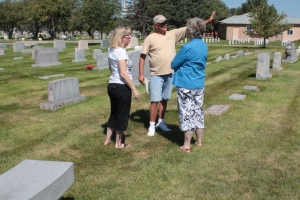

My sister and I drove over to Minatare to see my father’s childhood house at Avenue C & 7th Street…which was sold after my grandfather died and my grandmother moved to Florida. What we found was a town in complete decay… the harsh August sun giving the appearance of a town fading into the dry baked earth. All of the churches have been abandoned, and many of the houses—and if they weren’t abandoned, they mostly looked like they should be. The family house is still there, but now painted a sort of purplish-fuchsia color. It certainly stands out and is one of the few homes that appears well-tended. You enter the town on Main Street around 9th Street. Parallel and to the west of Main you find Avenues A, B, and C, to the east of Main you find First through Fourth Avenues. By the time you hit Second Street the town is finished, bisected by the railroad and the cattle station. The most recent statistics I could locate lists the population of Minatare at 810 people in the year 2000. From what we saw ten years later, I can’t imagine more than a few hundred people live there today….and even that seems like a stretch. We encountered very few people. The federal post office was nicely landscaped, everything else looked closed up…the bank, the bar, the volunteer fire department. It felt a bit like we had walked onto a movie set…one that included roaming zombies. It was unsettling.

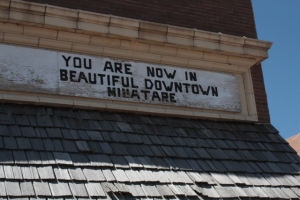
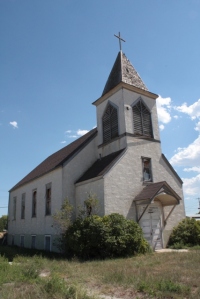
The heyday of Minatare was in the 1930’s and ‘40’s…the town started to thrive when the Great Western Sugar Company built a towering brick factory there in the 1920’s, as the area was surrounded by sugar beet fields. Changing technology meant Great Western needed fewer sugar factories, so by the late 1940’s they consolidated and the Minatare location was abandoned…the factory was torn down and the land was turned into a feed lot for Shorthorn cattle in 1956. It seems to have been a long slow downhill journey ever since… gone are all the restaurants, stores, and businesses that once inhabited Main Street. The regal red brick Minatare High School, which had been built during the same time as the sugar factory, is one of the few buildings that hint at the town’s former glory. This is the place my father played football, ran track, and chased girls. I have his 1950’s era lettermen’s sweater tucked away in my mother’s cedar lined hope chest.
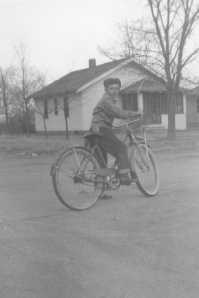

I remember once, as a little girl, taking a walk through Minatare with my grandfather and father. Grandpa Fred pointed out about eight houses among the several short blocks…all the places they’d lived before they eventually settled into their final house on 7th Street. My grandfather never wanted to be a farmer…and he seemed to have tried out any number of things… he owned a grocery store and a liquor store, he was a fireman, during World War II he was the fire chief at the Scottsbluff Army Airbase, and in his later years he served as a state fire marshall. He was a Mason, and a member of both the Moose Lodge and the Elks Lodge. All in all I’d say my grandpa was a happy man. Satisfied.
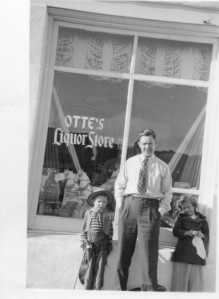
Yet not even my grandfather died in the place he called home. He was tragically killed in a car crash at the age of seventy-six, while driving cross-country on a winter’s day. An eastbound truck hit a patch of ice, traveled across the median into the westbound traffic, hitting the car my grandmother was driving. The truck hit the passenger side of the car, killing my grandfather on impact. They were outside Davenport, Iowa, just over the Illinois state line. My mother, father and I drove to Davenport from our home outside of Philadelphia. We continued on to Scottsbluff along with my grandfather’s body, while my aunt and uncle from Michigan stayed with my grandmother at the hospital. By the time we reached Minatare, we found the family house had been readied for our arrival. The fridge was full of food and family members and friends were awaiting instructions. As we planned the funeral and waited for the arrival of my grandmother, a steady stream of visitors arrived at the house, their arms full of hugs and casseroles. There was a LOT of food. Finally someone arranged a calendar to organize the meals, so that everything was not delivered on the same day. My sister flew in from Idaho. I remember being amazed by this enormous community outpouring. Who were all these people who seemed to know so much about me? And after the funeral service, as we were driving out to the cemetery for the burial, I remember very distinctly that I turned around and looked at the line of cars that were following behind. All of those cars…all of those people…were there to honor my grandfather. The line of cars with their headlights shining seemed to go on endlessly, like those long Nebraska freight trains that have no beginning or end.
Neither my mother nor father wished to be buried in the Scottsbluff cemetery. When my dad left for college in Oklahoma, he never really returned. And even in his younger years he yearned to be elsewhere. He liked to run away to Southern California to stay with his Aunt Toots. After my parents married, they moved to Tarrytown, New York, where my dad had a job waiting for him. At some point, everyone in my family decided they didn’t want to be buried. The expense of a coffin and all that comes along with a burial seemed superfluous. The discussion through the years has become “where do you want your ashes spread?” Ironically (or maybe not), when my father died about six years ago, he too died in an unexpected location. My father had traveled to Indianapolis, Indiana for the annual Fire Department Instructors Conference. While there he died of complications from a burst appendix. Despite being far from home, he was actually surrounded by the community he loved best. All his friends and associates from his fifty-plus years in the fire services industry were in town too. I drove my mother to Indianapolis from her home in Kennett Square, Pennsylvania. When we arrived at the hospital (while my father was still alive), his closest friends were there to greet us and take care of us. When my father died two days later, they were there with us. They helped us arrange for cremation. And when I returned to the hotel to check out, I discovered our bill had been paid in full. As it turns out, my father’s home was more than a physical place—it was the community he built over a lifetime.
My father, always a bit of a cowboy at heart, said he wanted his ashes spread over the Monument Valley Four Corners area. Something about John Ford’s world of the old west spoke to his soul. In actuality, my father’s ashes still reside with my mother in Kennett Square. My mother is not yet ready to part with my father and perhaps she never will be. I’m sure my father is happy to oblige. My sister and I have decided that after my mother dies (some day in the future, many, many, many years from now)…we will take the ultimate road trip in honor of our parents…visiting each and every place my parents called home…leaving a bit of each behind.
I will always wonder what it would have been like to be born and raised in the same town, the place my parents were raised… and yes, perhaps to have a sense of where I’d like to to live my final days. And as to where I want my ashes to be spread? I have a feeling I haven’t yet discovered that place.

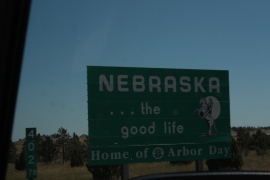
Ironically, I just stayed up until 2:30am to watch Gone With the Wind, the tale of a woman in search of ‘home’. I am enjoying your stories very much!
LikeLike
Thanks V…that means a lot!
LikeLike
Family lore says that when they lived in Nebraska, my great grandparents lived in a soddy house as well.
While most of my childhood was spent under one roof in one place, I’ve learned it wasn’t necessarily the same for my ancestors. It makes me wonder what they considered “home” to be.
Please continue the wonderful work.
LikeLike
Thanks for the kind words PJ…it made my day 🙂
LikeLike
It is so amazing to feel the sense of getting to know YOU while learning about your family. This is an awesome blog Mickey – I can’t wait for more!!!!
LikeLike
This post brought tears to my eyes. Thanks.
LikeLike
my mom requested I stop making her cry each week…I told her I would try! Thanks for the vote of confidence on this project…I appreciate it and all the genealogical work you’ve done too! We certainly come from an interesting family…
LikeLike
Mickey, this was beautiful, I too teared up while reading. Thank you for sharing.
LikeLike
thanks Terri!
LikeLike
This is my first time visit at here and i am in fact pleassant to read everthing at
one place.
LikeLike